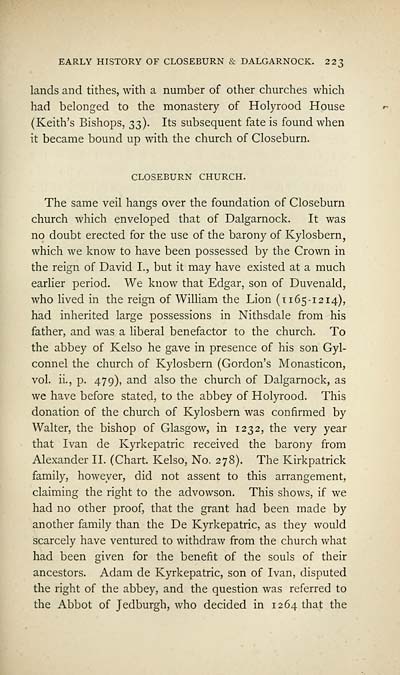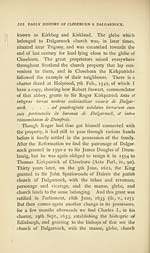Download files
Complete book:
Individual page:
Thumbnail gallery: Grid view | List view

EARLY HISTORY OF CLOSEBURN & DALGARNOCK. 223
lands and tithes, with a number of other churches which
had belonged to the monastery of Holyrood House
(Keith's Bishops, 3$). Its subsequent fate is found when
it became bound up with the church of Closeburn.
CLOSEBURN CHURCH.
The same veil hangs over the foundation of Closeburn
church which enveloped that of Dalgarnock. It was
no doubt erected for the use of the barony of Kylosbern,
which we know to have been possessed by the Crown in
the reign of David I., but it may have existed at a much
earlier period. We know that Edgar, son of Duvenald,
who lived in the reign of William the Lion (1165-1214),
had inherited large possessions in Nithsdale from his
father, and was a liberal benefactor to the church. To
the abbey of Kelso he gave in presence of his son Gyl-
connel the church of Kylosbern (Gordon's Monasticon,
vol. ii., p. 479), and also the church of Dalgarnock, as
we have before stated, to the abbey of Holyrood. This
donation of the church of Kylosbern was confirmed by
Walter, the bishop of Glasgow, in 1232, the very year
that Ivan de Kyrkepatric received the barony from
Alexander II. (Chart. Kelso, No. 278). The Kirkpatrick
family, however, did not assent to this arrangement,
claiming the right to the advowson. This shows, if we
had no other proof, that the grant had been made by
another family than the De Kyrkepatric, as they would
scarcely have ventured to withdraw from the church what
had been given for the benefit of the souls of their
ancestors. Adam de Kyrkepatric, son of Ivan, disputed
the right of the abbey, and the question was referred to
the Abbot of Jedburgh, who decided in 1264 that the
lands and tithes, with a number of other churches which
had belonged to the monastery of Holyrood House
(Keith's Bishops, 3$). Its subsequent fate is found when
it became bound up with the church of Closeburn.
CLOSEBURN CHURCH.
The same veil hangs over the foundation of Closeburn
church which enveloped that of Dalgarnock. It was
no doubt erected for the use of the barony of Kylosbern,
which we know to have been possessed by the Crown in
the reign of David I., but it may have existed at a much
earlier period. We know that Edgar, son of Duvenald,
who lived in the reign of William the Lion (1165-1214),
had inherited large possessions in Nithsdale from his
father, and was a liberal benefactor to the church. To
the abbey of Kelso he gave in presence of his son Gyl-
connel the church of Kylosbern (Gordon's Monasticon,
vol. ii., p. 479), and also the church of Dalgarnock, as
we have before stated, to the abbey of Holyrood. This
donation of the church of Kylosbern was confirmed by
Walter, the bishop of Glasgow, in 1232, the very year
that Ivan de Kyrkepatric received the barony from
Alexander II. (Chart. Kelso, No. 278). The Kirkpatrick
family, however, did not assent to this arrangement,
claiming the right to the advowson. This shows, if we
had no other proof, that the grant had been made by
another family than the De Kyrkepatric, as they would
scarcely have ventured to withdraw from the church what
had been given for the benefit of the souls of their
ancestors. Adam de Kyrkepatric, son of Ivan, disputed
the right of the abbey, and the question was referred to
the Abbot of Jedburgh, who decided in 1264 that the
Set display mode to:
![]() Universal Viewer |
Universal Viewer | ![]() Mirador |
Large image | Transcription
Mirador |
Large image | Transcription
Images and transcriptions on this page, including medium image downloads, may be used under the Creative Commons Attribution 4.0 International Licence unless otherwise stated. ![]()
| Histories of Scottish families > Drumlanrig Castle and the Douglases > (253) |
|---|
| Permanent URL | https://digital.nls.uk/95300327 |
|---|
| Description | A selection of almost 400 printed items relating to the history of Scottish families, mostly dating from the 19th and early 20th centuries. Includes memoirs, genealogies and clan histories, with a few produced by emigrant families. The earliest family history goes back to AD 916. |
|---|

